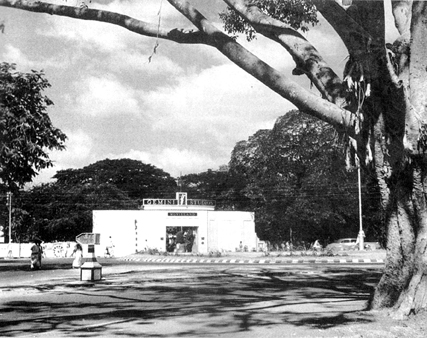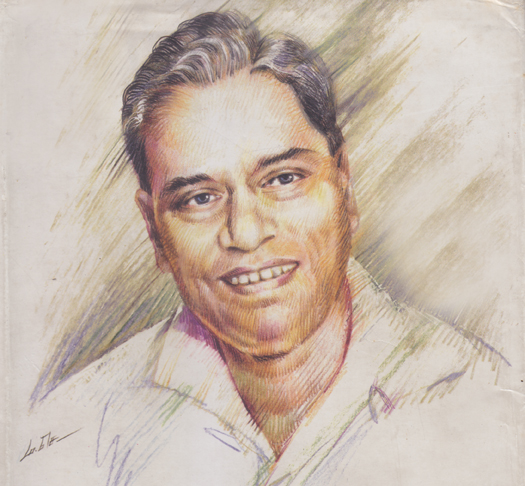
The entrance of Gemini Studios.
The very name Gemini Studios conjures up a magical world. Its sylvan location off Mount Road has since transformed into a concrete jungle, but each time you cross the area you can still imagine the glamorous stars, the huge workforce, the improbable storyline of most of its films and, above all, the enigmatic personality of its boss – S.S. Vasan.
Today’s generation came in at the tail-end of Gemini’s life. ‘The Boss’ died in 1969 and took with him most of the verve and enthusiasm for running a studio. It lingered on for a few years and then shut shop, plunging the cinema world into disbelief. Imagine life without Gemini. Vasan’s palatial bungalows on Edward Elliot’s (Radhakrishnan) Road remained as ghostly relics for much longer. The one opposite the Music Academy made way for a multi-storeyed office complex while the other, opposite Dr. Radhakrishnan’s residence, is now a vacant site, the collapsing gateposts alone feebly declaring to the world that this was where the great film-maker and studio boss once lived. But that the flyover on Mount Road is still referred to as Gemini indicates the hold the studio had, or still has, on collective memory.
For those of us who missed the glorious days of Gemini, the writings of Randor Guy have been our chief source of information. In the last decade or so, three publications have come out, each dedicated in its own way to Gemini. The first, in 2002, was My Years with Boss at Gemini Studios, published by Orient Longman. It is a compilation of veteran writer Asokamitran’s reminiscences of his years at Gemini. These originally appeared in The Illustrated Weekly of India (another legend of yesteryears) in the 1980s, when, acceding to editor Pritish Nandy’s request, Asokamitran jotted down his recollections. Though he served at Gemini between 1952 and 1966, the articles focussed on just five years – 1953 to 1958. But despite that, this is by far the best work on Gemini. In true Asokamitran style it is bitter-sweet, but it is a critical study of a time when the studio system was slowly giving way to star culture. Vasan was an astute reader of trends and portents and was getting his behemoth to make the transition as well. Asokamitran got a ringside view and captured it all. The book is a mere 47 pages! But within that it gives you a wealth of information and insights – the arrivals and departures of VIPs who wanted to see films being made, the peaks and troughs in a studio’s business cycle, the frustrations of those who came aspiring to be stars but ended up as office boys, the mountains of paper work that kept the studio moving and well accounted for, the stars who twinkled briefly … all of these come and go.

S.S. Vasan.
The second, more lavishly produced, is the S.S. Vasan Centenary Volume brought out in 2003 by Vasan’s other and more long-lived creation – Ananda Vikatan. While by its nature it is hagiographic, it has excellent black and white photographs from the Gemini archives. More importantly, it is structured as a series of articles by several people, all of whose lives Gemini and its proprietor had touched. There are Chief Ministers, political leaders and thinkers, rival studio-owners, film stars, writers (Asokamitran and Randor Guy included) and several former employees. R. Venkataraman, former President of India, has written of how he was made to write by Vasan and of the latter’s lifelong support for the Congress in Madras/Tamil Nadu and which party made him a Rajya Sabha MP as well. The best feature in the book, however, is a gallery of prominent employees of Gemini. It features an American, several Tamilians, Andhras, Kannadigas and Malayalis, a few Bengalis, a larger contingent of Hindi-speaking people and an Anglo-Indian or two. What a confluence of cultures the place must have been!
In its heyday, Gemini employed over 600 people, a huge number even by today’s standards. And it was the studio’s boast that it had never once defaulted on salaries! But it was this workforce that formed a union and eventually brought the studio system to its knees. A section devoted to ‘studio services’ is even more revealing. Vast armies of carpenters, tailors, musicians and, above all, make-up men. Of this last category Asokamitran in his book has a full feature on one man who doubled up as office boy and make-up man. In the latter role he had a simple job – mix something called pancake in a bucket of water and daub it on the faces of all the extras!
The last book, Gemini Canteen, was published in 2003 by Shanti Padhippagam. It was film historian Theodore Bhaskaran who alerted me about it recently, and another budding film historian, the actor Mohan Raman, sourced it for me. Written by N.S.S. Manian who for years managed the Gemini canteen, first as an employee and later, following the unionisation, as a contractor, it looks at Gemini from down under. But alas! what should have been a delightful book on the view from below is a meandering and badly structured work of 112 pages. Ploughing through it, you still manage to get the odd nugget or two, but it is a painful process. There are sections, however, that make you feel hungry – especially the menu for Gemini’s location shoots – sambar rice with plenty of ghee, potato chips, a curry, a deep-fried vada, curd rice made with milk, butter and a dash of curd, pickle. Tambrahm food at its best.
All three books write of the way Vasan publicised his films and roped in the VIP world-at-large to do its bit to ensure his films became a success. Without knowing it, even the film-hating Rajaji (according to Asokamitran, Vasan and Rajaji most cordially hated each other) had a hand in the success of Avvaiyar.
The Gemini motto was “When the bugles blow, there will be a show.” Vasan was all this and more when it came to family events as well. Navaratri at Gemini House involved full-scale sets erected by the studio technicians. All three authors write with awe of the manner in which Vasan celebrated his children’s weddings. As Asokamitran puts it, “For a whole week in 1950, citizens of Madras saw the moon at noon, the sun at midnight, men walked sideways on a hand and leg, birds stood as lampposts, the choicest music crystallised into diamonds, the smell of the most extravagant south Indian vegetarian food hung heavily on the air people breathed, the cows and buffaloes of Madras forgot to graze, the jutka carriages danced the polka and the waves of the Bay of Bengal stood still at their highest point to watch the fun.”
That was true of Gemini as well, wasn’t it?
|

